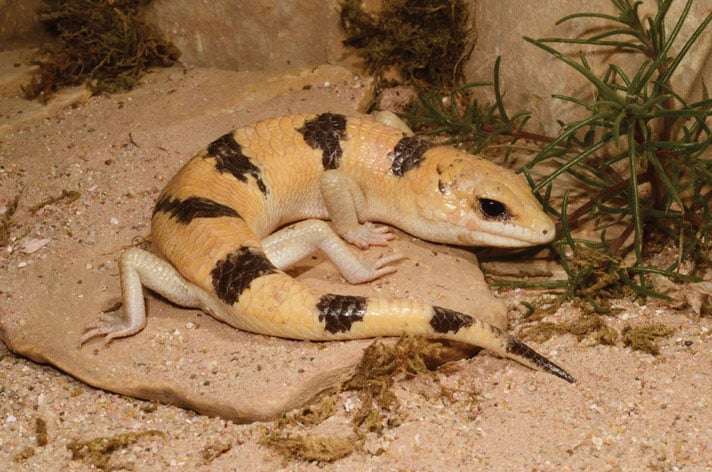
Description:
Scientific name: Scincopus fasciatus
Life span: 15-20 years
These are tiny reptiles that, when fully grown, measure less than a foot long. They have pale yellow bodies with black bars that span the length of them. Further variations between males and females have not been seen, though males often have a larger head and are bulkier overall.

Native Region/Habitat
The Sahel region of Northern Africa is the region of origin for the Peter’s banded skink (Scincopus fasciatus). These reptiles are acclimated to dry, hot settings with sand. Savannas, short grasslands, and shrublands are frequent habitats for them.
Behavior:
They frequently beg their owners for snacks and have a tendency to become fairly domesticated. The Peter’s banded skink has been compared to a bearded dragon in terms of temperament. They have a calm, docile demeanor. They seem to enjoy being handled by people, unlike the majority of other reptiles.
They get along well and can be housed in couples or groups. Nonetheless, there are situations when someone injures another after mistaking them for prey.
Care As a pet/In captivity:
Tank: As mentioned, you must choose a tank that is at least 20 gallons big, or 18″ x 18″ x 12″ in size, for your Peter’s Banded Skink. The amount of floor space your skink has is more significant than its height because they aren’t good climbers and spend the most of their time on the ground in the wild. Your tank should be nearly twice as long if you have two skinks.
Heating (Temperature & Humidity): The basking area of your Peter’s Banded Skink’s cage should be at least 95° to 100° F throughout the day, while the colder side should be around 85° F. The enclosure’s temperature should be kept at about 75° to 80° F at night.
Feeding: Although being omnivores, Peter’s Banded Skinks rarely eat fruits and vegetables. Roaches, worms, crickets, or even chicken, fish, and eggs, which are all sources of protein, will make up the majority of your skunk’s diet. You should lightly sprinkle your skink with multivitamin and calcium pills before giving it food. If your skink’s enclosure lacks a UVB lamp, the calcium supplement is extremely crucial.
Although Peter’s Banded Skinks don’t require daily feeding, you should be sure to provide them with food at least once every two to three days.
Table





